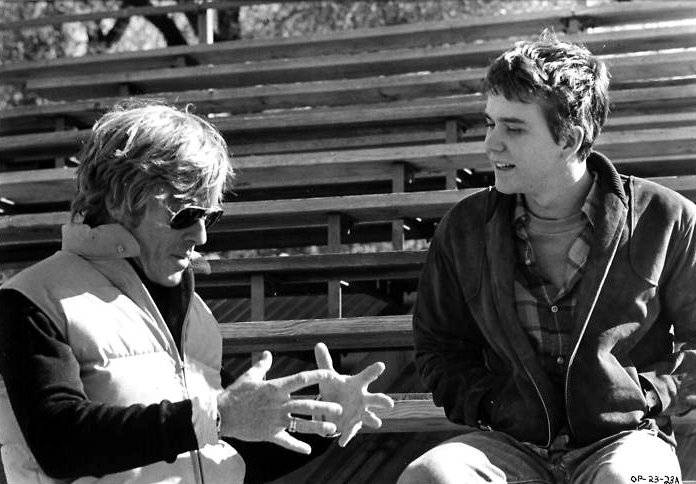 1.
1.
One of the greatest teachers of literature I ever had was a mathematician named Michael Comenetz. A spare-bodied man with a close white beard and a brown, bald head, Mr. Comenetz (who still teaches at my college, St. John’s in Annapolis) sort of resembles Don Quijote in looks, though in spirit he has more in common with Cervantes–patient and thoughtful, gentlemanly, with those subtly glittering eyes you see in people who are both very wise and very funny. Mr. Comenetz once interrupted a discussion, I think it was on Homeric heroism, by whistling the theme from High Noon, until all of us fell silent, one by one. At my college, seniors must read a good chunk of Marx in the late spring; if you have Mr. Comenetz for this, he will insist that your whole class sing a rousing rendition of The Internationale. There is a fragment of Heraclitus’s which puns on the Greek word bios, a word which can mean both “life” and “bow” (Guy Davenport translates it, “A bow is alive only when it kills.”); after reading this fragment, Mr. Comenetz asked that we at least try, to create, in English, a similar pun out of the many homonyms attached to the spelling “bow.” We were wildly unsuccessful, but of course success didn’t matter to Mr. Comenetz’s method. He was challenging us to engage with high culture at the most playful level possible. He is, himself, a supreme technician of letters (he writes an excellent blog; you can read it here), but one who understands that literature, even great literature, is nothing but a chest of toys. He co-authored a translation of Paul Valery’s The Graveyard by the Sea, and was the first person I ever heard tell that joke about Vassar girls, the one where they’re laid end to end, and no one is surprised.
Well, so one day, Mr. Comenetz gave an informal talk on the subject “Maps and Similes.” A map, after all, is a simile of the world, or a small part of it. (See, e.g., the Eschaton episode from Infinite Jest, where catastrophe breaks loose because one player ruthlessly lobs a ball at another, misunderstanding that the player’s body is not the coalition of countries she represents, but rather that coalition’s presence on the map, a simile for it.)
I asked Mr. Comenetz, “Why similes? Why not metaphors?” His answer was something like this:
“Well, I don’t really trust metaphors. They are necessarily untrue, aren’t they? Saying this is this? Of course it isn’t. This is like this, sure. But the servant’s brow is not a moody frontier. King Edward hasn’t actually sped up the seasons, and made summer out of winter. There’s a kind of preposterousness, you see, at work in every metaphor . . .”
2.
All apprentice writers struggle with finding their “voice.” By voice, I think we mean the peculiar stamp that separates my writing from yours, and yours from hers, and hers from his; in other words, it’s one of those Potter Stewart-type things: hard to define, but you know it when you see it.
Contrarily, one of the quickest ways to tell that a writer isn’t ready yet–that he or she still needs work–is when the writing can’t be separated out from the writing of others. I see on the Twitter the complaints of people (slushpile trusties, for the most part) who are seeing page after page of transparent imitation: lots of Cormac McCarthy wannabes, I hear; even a few Tao Lin apers, for reasons passing understanding.
To these writers, I could not be more sympathetic. My earliest serious attempts at fiction-writing were themselves parrotings of Cormac McCarthy that would curl your toes. Here, let me show you:
The young man’s steady, rhythmic cries were the dominant sound in the room, as if he held the floor in a parliament of grief. Steadily those of his wife seeped in, filling the spaces between his with her coarse, dynamic sobs. The man’s cries like grunts and the woman’s like moans, the silence of the elders surrounding and supporting them like as the cold bleak of space to a chaotic and liferidden planet.
Ye gods: “like as the cold bleak of space”? “a chaotic and liferidden planet”?
In my defense, however, this is how it gets done. Remember in Finding Forrester, how Sean Connery jumpstarts the young guy’s writing by having him re-type one of his (Sean’s) old essays? We’re all doing that, in the beginning. We imitate writers in order to learn. Hunter Thompson used to copy out lines from Gatsby on his typewriter. He wanted to feel the rhythm of those words, as they came out, letter by letter; he wanted to know how it felt to have prose like that jump into being, underneath his own fingers.
This is natural, this is what John Cheever called “the parturition of a writer.” Each apprentice takes bits and pieces of the masters and builds up a kind of jury-rigged scaffolding, like one of those wobbly towers made of pianos and bird cages you see in old cartoons. You can reach a nice altitude on something like that, but it’s treacherous. To create good and original prose, one needs sturdier footing.
3.
Mr. Comenetz’s preference for simile over metaphor is idiosyncratic, reasoned, hard to argue with, and slightly, just slightly, insane. If one is abandoning metaphor because all metaphors are preposterous lies, then one must abandon all fiction, if one means to be consistent. Clearly, Mr. Comenetz didn’t mean for his point to go that far.
This preference of his, however, is a perfect example of the little stylistic choices a writer must make, the scruples of taste she must develop, in order to gain a voice. In short, I think a writer’s voice is simply what happens when he or she applies private rules–a kind of second grammar.
It will be easier to elaborate if I give an example from my own private rules. Me, I adhere as strictly as I can to the common notions of spelling and punctuation. This wasn’t always the case with me. Back when I was drunk on McCarthy, I slammed words together and ditched quotation marks all day long. This was not a stylistic choice, however; this was not the application of my own private rules. I had not worked through any process like the one by which McCarthy decided to use enjambment-coinages like “scabbedover” and “rubymeated,” and neither did I have any good reason to leave off punctuation marks. I was imitating, superficially. I wasn’t getting past the appearances to find the solid form beneath, and that was fine: I hadn’t earned that yet. I hadn’t done enough reading or enough writing to earn that. By the time I had, though, I’d learned an important truth about myself: I need as much structure as I can get. I need the safety of it. I’m not a tightrope walker: I take hiiigh steps anytime I get off an escalator.
And it hardly needs to be said, but my way is not your way, nor should it be. Faulkner, for instance, was a tightrope walker. Lord only knows what that man thought this thing “;–” meant, but he used it all the time. If that’s your way, too, then you’re in good company. I do think these choices should be deliberately made, though, and the reasoning behind them should be both sound and personal. It’s not enough to abandon traditional punctuation merely out of homage–the choice must be original, and guy-lined by the writer’s personal vision. Faulkner, I think, did it because he sensed a great fracture in the world, a brokenness, an incommensurability between truth and regulated description. It won’t cut the mustard to do the same thing just because it strikes you as cool (which, if I’m being honest, is why I did it).
4.
The more one reads, the more one sees these little rules, these underlying knowledges, at work in all the great writers. Charles Portis, like Jerry Seinfeld, works clean: you’ll find very few curse words in his books. Portis also seems to think that any time two characters are talking, they might as well be fighting. This is not a bad rule to test out, in your own work. Alice Munro nearly always tells you what her characters look like, but not always the first time you meet them. There is a great insight into the manipulability of the short story in this; it displays a powerful understanding of how the mind and heart meet imaginary people, and of how an invented person comes to be cared for by readers. Stephen King hardly ever lets his narrative voice depart from that of The Friendly Co-worker, the kind of guy who’s quick with an easy joke or a breezy bit of small talk; this is powerfully American of him, and when future generations want to know how the post-World War II middle-class talked to itself, they will miss the mark wildly if they don’t consider King.
Here’s a question: What’s the point of writing fiction if another medium could serve your material just as well, if not better? It’s a critical concern for all of us, and I think the answer to that question is one of the rules that guided David Foster Wallace in his writing. I don’t think he ever wanted to do something that a filmmaker, showrunner, painter, or musician could do, too.
E.g., when Wallace employs long block paragraphs of narration, with a rotating perspective, he’s doing something it’s impossible to do except in fiction: he is creating a slow-motion, extreme close-up, Altmanesque crowd scene. Re-read the final locker room segment from Infinite Jest (20 Nov. Y.D.A.U.). Ironically, when all those characters are tossed into long paragraphs together, jumbled up in that big wall of text, we can see more vividly each of the little things they’re all doing. Wallace starts with a packed room and moves closer; he takes small character movements–each one a part of a sequence, each sequence a little story all of its own–and makes each of those movements central and enormous for the length of a phrase or a sentence; he goes from one character to another, to another, to another, then moves back. The effect is a rigorous re-mapping of life into narrative, and it just can’t be done any other way. You’d have to paint some huge Boschian canvas and then animate each character as it acted out its own peculiar torment, or whatever. Even then, the artist would have no control over sequencing; and with a canvas large enough to present sufficient detail, a debilitating physical distance would arise between the viewer and large parts of the painting: one might see the lower third fine, but the middle third poorly–and the top third hardly at all. Even Altman couldn’t do something that Altmanesque, because time in a movie, at least in a scene like that, has to move at normal speed–you miss things when you can’t slow down, re-read, when your eyes have to dart all over the screen to keep up with what’s happening. Fiction has limitations cinema doesn’t–as McCarthy noted in conversation with the Coen brothers (published in Time, but only available to subscribers), you sort of have to believe what you see on a screen, because you see it; that’s not at all true of what you read on a page, so problems of belief-suspension are trickier for fiction writers than for filmmakers. Of course this cuts both ways, and a movie could never cooperate with a mind as intimately as a page of prose can–the stops, the re-do’s, the run-backs, the skips-forward: all these little tools a reader can wield when breaking down a text are exclusive to the form. (And thank God, because writing needs all the help it can get.)
5.
A breakthrough has to come before imitation gives way to real influence. There have been plenty of young writers–God bless them–who’ve gotten drunk on DFW, the way I got drunk on McCarthy. Y’all on slush detail know who they are, from the footnotes and the ambitious vocabulary, to the funky little tri-particle transitionals, (“and then so” “but so then” “so now but”), that Wallace was so fond of and used so well. And like I said, that’s fine, that’s normal–it’s like kissing poorly the first few times you do it.
Perhaps that’s the correct metaphor for an apprentice writer copying a master: a person who’s never kissed before making out with an accomplished osculator; there will be learning done, but it will be of limited general utility. Everyone else is going to be different, because kissing means different things to different people. Until a person understands what kissing means to them, they won’t be able to share that meaning with anyone else; nor will they be able to find out if what kissing means to another person matches what it means to them.
This is a small model for how the writer learns the craft, because it’s a question of learning why the craft matters. You copy the work of others, trying to see what it meant to them, until you’ve learned what it might could mean to you. And even then, you aren’t complete. You need what Franzen calls material, what Updike called his assignment. And that is a discussion for another day.
Still, it’s possible that learning what rules one wishes to apply to one’s material–the process, I’ve argued, of finding one’s voice–is a journey that goes hand in hand with learning why you want to write in the first place. Both these things are part of the larger project that all human beings are engaged in, of seeking to know ourselves. In Barry Hannah’s great conversation with Wells Tower (published by The Believer; you can read it here), Hannah says a thing you don’t often hear said about writers: that they are, for the most part, good people. Sure, some of us are jackasses, but Tower has to agree with Hannah, remembering that there’s a humility which gets beaten into your head, when you’re working at becoming a writer. From humility, goodness tends to follow.
The crushing humiliation of straining your soul, over and over again, only to produce hundreds of dog-gagging sentences (“like as the cold bleak of space to a chaotic and liferidden planet”) is the gauntlet you must run before you can become a better writer. It is possible, let us hope it is possible, that this and everything else you go through might also, in the end, make you a better person.



